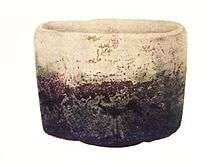Donabe
Donabe (Japanese: 土鍋, literally "earthenware pot") are pots made out of a special clay for use over an open flame in Japanese cuisine, and in the case of semi-stoneware Banko ware of high petalite content.[lower-roman 1] Often, the food is cooked at the table on a gas burner for various nabemono dishes such as shabu-shabu and dishes served simmering including nabeyaki udon. They are sized by sun, one of the Japanese units of measurement.

The donabe is usually glazed on the inside[lower-roman 2] and porous on the outside. While the material is similar to earthenware or stoneware, donabe can be used over an open flame as well as in an oven if three precautions are taken. First, the outside of the donabe should be dry before use, as moisture within the clay will expand in the heat and may chip or crack the pot. Secondly, the pot should be heated gradually to reduce the possibility of cracks due to heat stress. Third, the pot should never be left over the flame while empty.
If properly treated, these pots should last for decades and a few special ones have survived for centuries. When a new donabe is obtained, one should let the donabe boil water for hours and dry before using it for cooking. Other sources suggest that the user should simply fill the donabe with water and let it sit overnight. This process should be repeated if the donabe has been unused for a long time.
In old ryoutei of Kyoto, decades-old donabe would be stored and only used for special guests. Young donabe would be used for preparing lunch menus and food for cooks, to age them for this purpose.
Donabe is produced by potters of Banko ware,[1] Iga ware,[3] Shigaraki ware,[2] and Mashiko ware.[4]
Notes
- According to 萬古陶磁器卸商業協同組合 (Bankoyaki Tōjiki Oroshi Shōgyō Kyōdō Kumiai) wholesalers of Banko ware pottery, they claim to ship close to 80% of donabe in the wlesales market, and reasons that the high content of lithium, or petalite, in the pottery clay reaches up to 40-50% of the volume. They say the clay keeps their donabe popular for the excellent heat resillience against direct flame such as gas cooking stove and charcoal fire, or even when being boiled dry.[1]
- A Shigaraki ware potter had introduced silica coat applied on the inside of donabe as to replace fluoropolymer coating which he was not satisfied but wore down after years of scrubbing with cooking and washing tools. He claims that silica hardens the inside surface of the pot, which makes it easier to fry and grill foods in donabe with less burn in the bottom.[2]
References
| Wikimedia Commons has media related to Donabe. |
- "Yokkaichi bankoyaki towa" [What is Yokkaichi Banko ware] (in Japanese). Bankoyaki Tōjiki Oroshi Shōgyō Kyōdō Kumiai. Retrieved 2017-10-03.
- "Sirika kakō nabe" [Silica coated donabe] (in Japanese). Kanefusa Seitoō. Retrieved 2017-10-03.
- "Iga Mono (also known as Iga-yaki or Iga Ware)". Retrieved 2017-10-03.
- "Tochigi dezain taishō, "Kamakko" ga saiyūshūshō — 1-gō wo suihan dekiru Mashiko no tsuchigama" [Tochigi Design Grand Prix for "Kamakko"]. Shimotsuke shimbun. 2017-08-18. Retrieved 2017-10-03.


